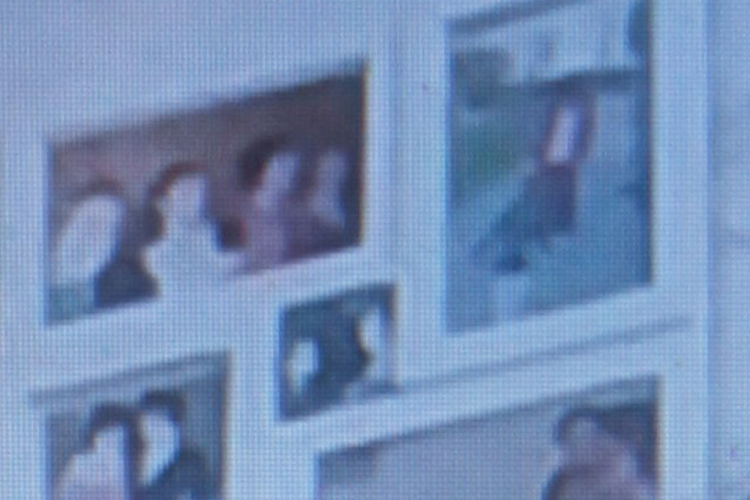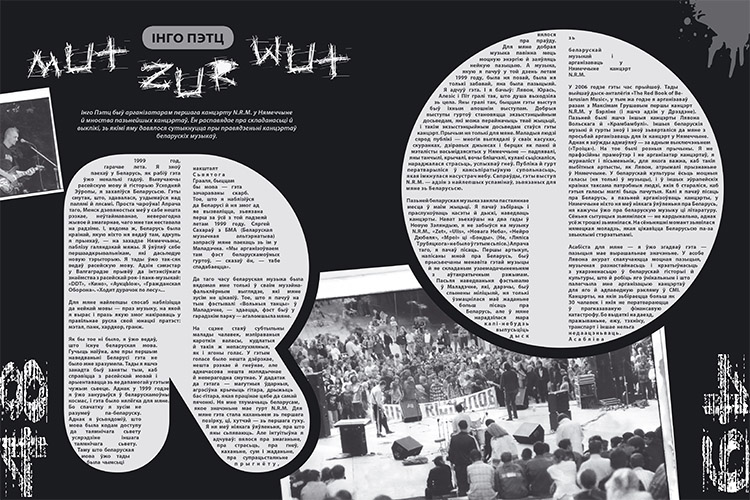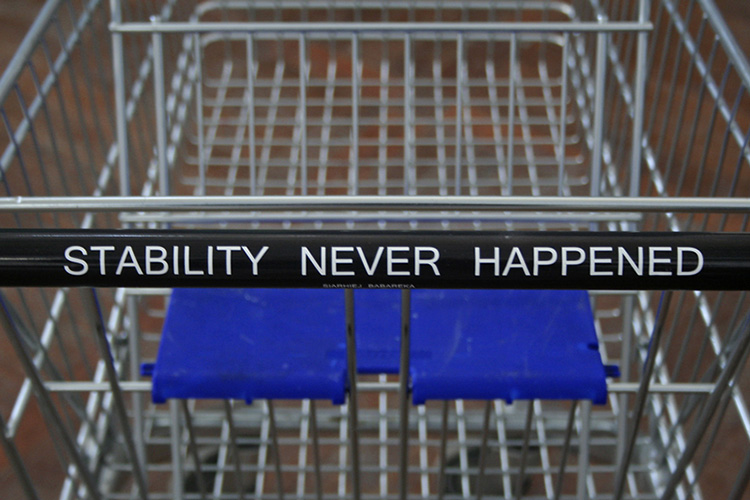
Аўтар: Vadzim Dabravolski, 31/10/2014 | ART Cult Aktivist project SPECIAL
SUBVERSIVE PRACTICES OF CONTEMPORARY ART IN BELARUS
ON IDEOLOGY AND CONTEMPORARY BELARUSIAN ART
In order to understand what kind of subversive potential contemporary art has in relation to the acting Belarusian authority and how this potential is implemented, it is required to analyse the nature of the authoritarianism in which it exists. There is a common policy in the non-governmental journalism and political science to limit the authoritarianism to the physical state control of such resources such as state bodies of defence and attack (the army); state bodies which exercise punishment (the judiciary system and the police), and the bodies which execute political rituals (the parliament, different administrations, etc. ).
However, this approach overlooks the mechanics of totalitarian power in its multidimensionality, a particular aspect of its implementation, namely its monopoly to produce and maintain the established truth, that is, its ideology. Totalitarianism of the ideological discourse of power in Belarus does not rely on the fact of its existence. Any power (whether Arab religious states, Asian style of communism or Western democracy) has its own more or less articulated ideology that seeks to dominate any alternatives.
This struggle of ideologies is inseparable from the struggle for power.
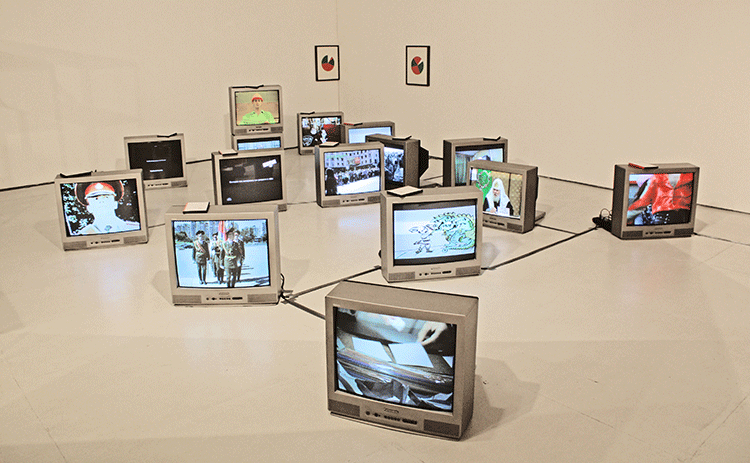
Marina Naprushkina «Anti-propaganda Bureau»
To counter the dominance of ideology in the public consciousness, the Belarusian independent community more and more often articulates the idea of having a public platform where agonistic competition among different discourses would be possible. The rivalry among them would thus generate new meanings. Contemporary art becomes one of such platforms.
The idea of contemporary art as a communication platform in Belarus is relatively new and has been circulating in the public media space with some modifications since mid 2000’s. This can be explained by a number of historical circumstances. Until recently, the Belarusian art was dominated by two movements: the art partisan movement and official art. The latter is still a conformist version of the artistic autonomy which lives under the wing of the state. Art-partisan movement was, in turn, a defensive reaction to the ban imposed by the authorities on the independent and active, in terms of ideological dimension, art in public space[1]. This unspoken ban has secretly existed for as long as the practice of contemporary art in Belarus has existed. Such a situation forced independent artists to apply «underground» practices of the local artistic resistance: it was confrontation with the imposed classical tradition of art, and to a much lesser extent, with the symbolic power of the state.
Due to the locality of the context and narrow range of choice of the actual topics, art-partisan movement is outdated in the current circumstances. A time has come when the paradigm of the independent art should be changed.
With the advent of a number of key critical texts on art and publicity,[2] independent media sources and new showrooms, the paradigm of contemporary art as a communication platform is now at the early stage of implementation in Belarus. Within this context, the particular works of art and exhibitions play a structural role in relation to the arrangement of new meanings in the public discourse. Through its ability to reinterpret the existing truth, contemporary art thus invades the territory of the ideologies of power.
This kind of intervention can be seen if one looks at three events in Belarusian contemporary art: the art of the painter called A.R.Ch (A.R.Č)., the project by Marina Naprushkina (Maryna Napruškina) «Anti-propaganda Bureau», and the exhibition of Zhanna Gladko (Žanna Hładko) works «Inciting Force» (December 2012, Gallery Y, Minsk).
THE RETURN OF DEATH
The ideology does not only have a power to freely manipulate the meanings circulating in the public space. The mechanism of ideological control to exclude the unwanted signifiers from the public space is no less important. Something that is excluded doesn’t exist. Therefore, it is natural that Death was also excluded from the public discourse in Belarus (a country of «Orthodox atheists» where religion is still fulfills a decorative function). Death as something which one constantly faces with and speaks about, takes a shelter in the villages and shabby sleeping districts, but not in the public consciousness.
In the autumn of 2011, Y Gallery presented an exhibition «Like in the Horror Tale» of the works of the artist with a nickname A.R.Č. (initials of the serial killer Andrey Chikatilo). Most of the works were devoted to the maniac and his victims, making up a really terrible and bloody tale of violence and decadence. It is not surprising that this exhibition provoked a strong public reaction varying from attempts to interpret the exhibition, based on its denial as a phenomenon of the contemporary art, to accusing the galley of promoting violence.

A.R.Č.
The latter has to be paid more attention to, as following these logics, most of the film directors and TV channels should be banned because they much more systematically show scenes of violence much younger and much more inexperienced public [3]. It is likely that the accusers angered by the fact that the exhibition made them encounter with Death which differs from the traditional theatrical entertaining unreflective to the viewer Death on the TV screen:
What A.R.Č. did within the frameworks of the exhibition is that he extracted Death in its extremely rich visual form from the oblivion to the surface of public discourse. The Death which forces viewers to reflect on it and make an attempt to interpret it.
In case with A.R.Č.’s exhibition, death becomes the «screen of fantasy» (Slavoy Źiźek), on which were projected different interpretations affecting social issues of life and death in small towns and the state of decadence that prevails in them[4]. The difference in the perception of Death between a big city and a provincial town became another provocation to the further interpretations that the exhibition had evoked.
REVISION OF THE FATHER IN HOMELAND
The ideology of the state is made up of combinations of many local ideologies which naturalize more specific statements about the truth. One example of this ideology is the ideology of the family, according to which the family is universal and most natural form of coexistence of Father and Mother. However, this ideology is characterized by a predetermined inequality of the roles of Father and Mother: Father is active and creative, while Mother is passive and protective.
Inherited from Christianity, the ideology of the patriarchal family has practically remained unchanged in Belarus up to now.
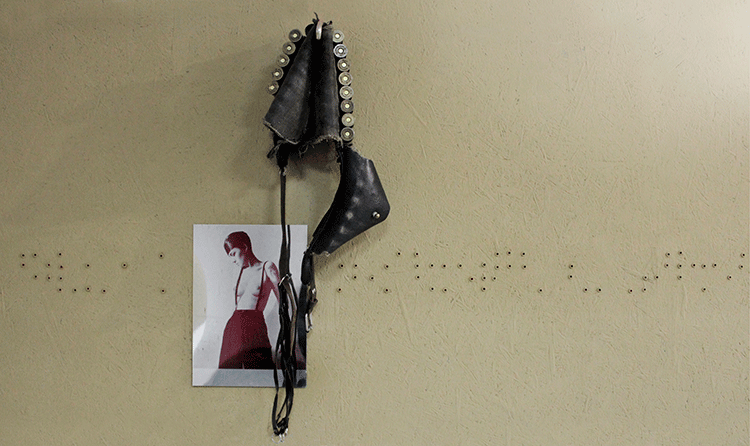
Zhanna Gladko «Inciting Force»
Zhanna Gladko’s exhibition «Inciting Force» held in December 2012 initiated a revision of the symbolic figure of Father. At the exhibition the artists presents ready-made family archive and artifacts representing or symbolizing her relationships with her own father. Thus, one can see at the exhibition her photos as a child, audio and video records which bond the artist and her father, as well as those symbols of her father’s power that she had learned: his ammunition belt, his prey (dead forest animals), his territory, and his Daughter.In the end, the combination of these symbols of power gradually dissolves the story of real people in the background, and a symbolic figure of the Father appears in the foreground: the defender and breadwinner, on the one hand, and the tyrant, on the other hand.
This manifested the very «inciting force» that has given a title to the exhibition: within a harmonious ideological construct called «patriarchal family» appears an immanent conflict.
The curator of the exhibition Sergei Shabokhin formulated a thesis that this exhibition show does not imply a certain view of the symbolic figure of the Father (in other words, a predetermined signifier for the signified). It is rather «a veil for the ambivalent objects»[5] that cannot be clearly classified and possess a duality of meanings and experiences.However, according to the author of this thesis, it is appropriate to radically extend the number of the possible meanings, and shift from the dichotomy of Father and his symbols of power to their polisemy.
As a first step, Sergei Shabokhin supplemented the materials with two interpretations of the exhibition in different discourses, namely, the phenomenological and feminist. Obviously, there will be much more interpretations after the exhibition. In the end, critical texts and discussions in the media will lead to the full-scale revision of the symbolic Father and the ideology of the patriarchal family in the public space in general.
DISRUPTION OF THE IDEOLOGY OF POWER
The abovementioned examples of artistic diversions into the ideological field didn’t address a more total and relevant political discourse directly. Marina Naprushkina, in contrast, has chosen a deconstruction of the state ideology as an object of her creative activity. She focuses on the various media symbols of power, from portraits of Lukashenka to the tractor «Belarus». By using different semiotic strategies, she has been deploying these symbols.
One of the most important works of Naprushkina is «Anti-propaganda Bureau» presented in 2010 at the exhibition «Opening The Door? Belarusian Art Today». In this installation, Maryna brought together many examples of ideological propaganda in Belarus. Taken out of context, these ideological signs, first, have lost their power, and secondly, have become the subject of the viewers’ active research. Laid out on the shelves, collected in piles and catalogues, these ideological artifacts rather resemble laboratory specimens for dissection. In addition, being put together, they formed an avalanche of clearly different elements, thus questioning the possibility to bring together in one picture the eclectic ideological products of the Belarusian authorities. Such a deliberate strengthening of ideological symbols, like it is done in the installation «Anti-propaganda Bureau», clearly violates one of the fundamental principles of power, namely, its desire to impersonate a natural state of affairs.
Thanks to this, propaganda material not only becomes neutral and easy to research, but also becomes really anti-propagandist in the eyes of the viewer.
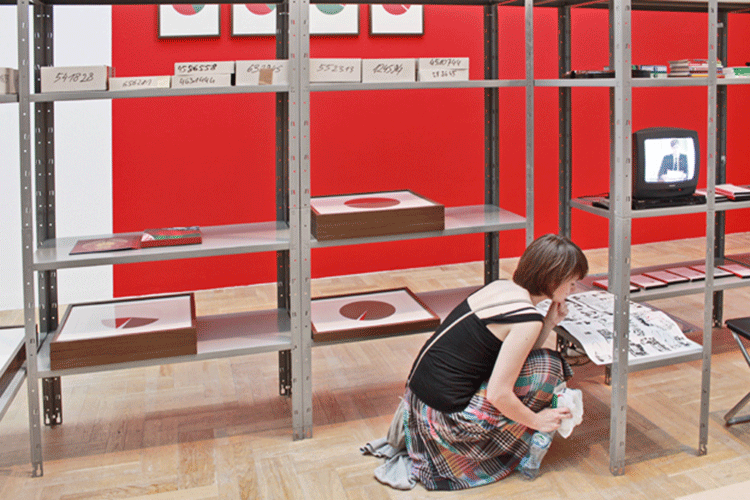
Marina Naprushkina «Anti-propaganda Bureau»
Another example of Marina Naprushkina’s art diversion is a colouring book «My dad is a Policeman. What does he do at work?» The comic book contains real-life stories of people who were victims of violent and illegal actions of the police during the opposition protest rallies, and scenes where a plasticine policeman exercises such behaviour in respect to a plasticine woman. This comic demonstrates how connotations override the signifier «The Policeman». Instead of the halo of personal heroism and law-abidingness, which the respective billboards in Minsk promote, the signifier acquires sharply negative characteristics, such as brutality, lawlessness, injustice.This change of connotations has become possible thanks to the fact that personal narratives of victims of the police make up one whole picture in the book.
Marina successfully uses the fact that any ideological beliefs fade away against the real-life stories of real people, just like those who would read this colouring book. Meanwhile, it raises another interesting question: the main target audience, as the name of the book suggests, are families of police officers.
Thus, the book not does only change the meaning of the signifier, but also penetrates each policeman’s private space in which they are not functions of authority, but family men.
***
The examples of work of A.R.Č’s, Marina Naprushkina’s project, and Zhanna Gladko’s exhibition as subversions of contemporary art are single-time actions by their character, and are only indirectly related to the political discourse. Therefore, it would be presumptuous to expect any significant revolutionary potential of contemporary art in the short-term perspective, because in the case of Belarus, the authoritarian system pulls together in a tight tangle different practices of subordination, which act in different dimensions. It can be concluded that subversive practices must be as diverse.
The independent art field has a structural function, which is to ensure conditions to implement agnostic competition among various discourses, and by doing so, establish a democratic tradition within the authoritarian context. However, while giving specific material for contemplation and interpretation, the art field also acts as a catalyst of opportunities for the viewer to get «cleansed from the stereotypical perception of the principles, practices and judgments (or prejudices), rooted in the tastes and words»[6].
Ultimately, it is the formation of a new type of subject through contemporary art that is going on. A subject who is actively doubting and exercising his right to choose meanings. A subject which belongs to the European democratic tradition.
Vadzim Dabravolski
[1] Volha Šparaha (Olga Shparaga) notes that the entry of contemporary art in public space in Belarus was problematic. A bight example is the first public exhibitions of avant-garde on the Niamiha river embankment in the center of Minsk during perestroika. Despitethe support of passers-by, these exhibitions were severely repressed by the police, and the pictures were thrown into the river (see: O. Shparaga. Democratic Potential of Cultural Practices in Modern Authoritarian regimes: A case of Belarus // Post-Soviet publicity: Belarus, Ukraine. EHU.2008. p. 158–186.
[2] For example, the text by Volha Šparaha mentioned above.
[3] The entry to the exhibition «Like in a Horror tale» was banned for persons under 18.
[4] A.R.Č. lives in Žodzina, a small town near Minsk where most citizens work at heavy industry plants .
[5] Shabokhin,S. A Veil for Ambivalent Objects. URL: http://ygallery.by/exhibitions/0004778/
[6] Lazzarato, M. Arts, work and politics in the disciplinary society and a society of control // An art magazine. 2009. № 73/74.
Photos © A.R.Č’s, Marina Naprushkina, Zhanna Gladko
Opinions of authors do not always reflect the views of pARTisan. If you note any errors, please contact us right away.



